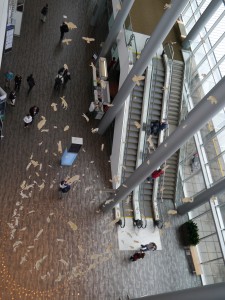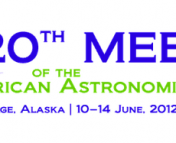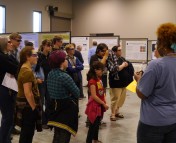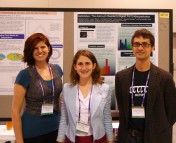Astrobites is again liveblogging AAS! In order to avoid inundating our readers’ RSS feeds, we’ll be updating this post with short paragraphs about the talks we’ve heard and posters we’ve seen. So keep checking back throughout Tuesday morning!
11:40 am: Russell Prize Lecture – Sandra Faber, UC-Santa Cruz
And the Russell Prize, the astronomical lifetime achievement award, goes to Sandra (Sandy) Faber, the head of the graduate program at UC Santa Cruz, the first astronomer to receive a grant for 900 Hubble orbits of observation time, who, with 98 first-author publications, 505 publications in total (according to the SAO/NASA Astrophysics Data System), and 30,000 citations, has achieved more in her lifetime than these quantitative distinctions suggest. In her talk, Sandy covered the many triumphs and few tribulations of the lambda-cold dark matter (lambda-CDM) model of the makeup of the universe. My favorite success of the lambda-CDM model she reviewed (and, incidentally, her own contribution) was how, as galaxies grow via mergers with other galaxies, their mass affects their star formation rate. Galaxies begin forming stars when they cross a certain minimum mass threshold of about 10^10 solar masses, and the star formation shuts down when galaxies exceed about 10^12 solar masses. Sandy demonstrated how these trends in mass growth and star formation history predicted the complicated distribution of galaxy types we see today, from the “large, red, and dead” ellipticals that stopped forming stars only a couple billion years after the Big Bang to the small irregular galaxies that are just blooming in a burst of blue, youthful stars. Our neighbor Andromeda, which weighs in at 10^12 solar masses, should be on its last gasp of star formation. Accordingly, only a thin strand of new blue stars surrounds the death pit of red and yellow in its bulge. Sandy also pointed to today’s setbacks of the lambda-CDM model, including the puzzling issue of how the stellar initial mass function seems to evolve over time.
10:00 am: WFIRST Meeting-within-a-meeting
WFIRST, the Wide-Field InfraRed Survey Telescope, was the #1 priority for the Astro2010 Astronomy & Astrophysics Decadal Survey amongst large space missions. The satellite, whose mission goals included dark energy, exoplanets, and infrared survey science, was to be launched in 2020 and have a total US production cost of ~$1.6 billion. However, extreme overflows in the budget of the James Webb Space Telescope (JWST) have caused development of WFIRST to stall and be pushed back. But the project is far from dead: Today’s one-and-a-half hour session was the first of two in WFIRST’s “meeting-within-a-meeting” at this Anchorage AAS, and provided both updates on the project as well as convincing evidence that it should go forward. Several “big names” in astronomy spoke on WFIRST’s behalf, including Paul Schecter (of MIT and Press-Schecter fame), Alan Dressler of the Carnegie Observatory, and Richard Ellis of Caltech. Paul first spoke of the progress made by the WFIRST science team on reducing the cost while still maintaining the capability of the observatory. The two largest contributors to the immense expense of a space telescope are aperture size (weight goes as size^2!) and mission length (more redundancy, which is needed for longer missions, is very costly). The team has decided to reduce both, while moving to an off-axis design that greatly improves the camera’s Point Spread Function (PSF). Alan Dressler has been looking into the details of repurposing NASA’s newly acquired 2.4 m telescope (see our coverage of this recent headline) to fulfill the WFIRST mission objective, which it appears to be entirely capable of doing. A larger mirror obviously gives better sensitivity (and resolution), although field-of-view might be smaller than originally envisioned (this could be overcome with more pixels, potentially); however, the biggest argument in favor of using this “free lunch” is that a huge portion of the cost – building the telescope and satellite – are basically negated. After these two talks, it seems clear that WFIRST will proceed (they claim a possible launch in 2022), either as a lean, mean 1.1m-mirrored machine, or in the form of NASA’s recently acquired gift. Richard Ellis and Jason Kalirai spent the remainder of the session describing the great science across all fields of astronomy that WFIRST will enable – from gaining broad wavelength leverage for accurately characterizing nearby stellar populations, to increasing by orders of magnitude the number of distant (z > 6) quasars discovered. The truth is, there’s never been a wide-field infrared telescope of this capability before, and its ability to be a target finder for the most powerful upcoming facilities (such as the Thirty Meter Telescope and JWST) as well as its synergy with other survey telescopes (such as the Large Synoptic Survey Telescope (LSST) and Square Kilometer Array (SKA)) make it a very exciting project indeed.
10:00am Press Conference: A Matter of Some Gravity
This was a fairly unusual press conference. The first half was largely a historical review of gravity through the ages, covering not only ideas within our own culture before and after Einstein (presented by Stacy McGaugh of Univ. of Maryland), but also perspectives on gravity from ancient cultures pre-dating our own (presented by Virginia Trimble of UC Irvine). The second half of the conference consisted of self-proclaimed “extremely controversial” ideas about gravity. The first was Gerrit Verschuur’s (Univ. of Memphis) discovery that small-scale structures in the cosmic microwave background (seen in WMAP data) are closely correlated to the structure of neutral hydrogen within our galaxy, suggesting that the fluctuations seen in the CMB originate within the galaxy rather than having been formed shortly after the Big Bang, as is conventionally thought. A second controversial idea was put forth by David Bartlett (Univ. of Colorado), presenting an alternative cosmological model to the standard Lambda-CDM approach. In this new model, cosmological expansion is controlled by electromagnetic forces rather than by gravity, and that the photon has a non-zero (but very small) mass.






Trackbacks/Pingbacks